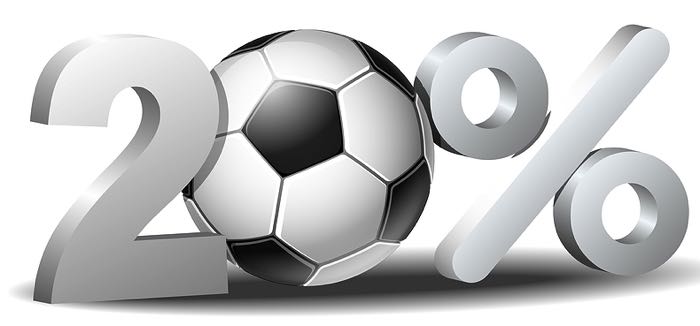 Football is often considered to be the number one global sport and it is certainly safe to say that it is the national sport in more countries than any rival game. It is also the sport that is most gambled upon, certainly in the UK, where, for many people, having a bet on the game is a significant part of their weekend ritual and part of their whole culture.
Football is often considered to be the number one global sport and it is certainly safe to say that it is the national sport in more countries than any rival game. It is also the sport that is most gambled upon, certainly in the UK, where, for many people, having a bet on the game is a significant part of their weekend ritual and part of their whole culture.
Given these facts, it should come as no real surprise that it is also the sport that offers the widest range and biggest number of different betting markets. That said, for all that you can back a player to be booked as part of a multiple with over 13 corners, under 3.5 goals and the second half to end in a draw, or opt to have a bet on whether the game will have a penalty, by far the most popular market remains betting on who will win a given match.
The match odds, sometimes referred to as “winner”, “to win”, 1×2 or HDA, is a simple bet on which side will win a given game. Of course, in football, there is a third option: the “x” in 1×2, or the “D” in HDA, and that is, of course, the draw. But is the draw worth backing? Is it a good bet that offers value or a stinker that should be avoided? How often do games end in draws and when might such a selection offer value?
Is a Draw a Good Bet?

It is not really possible to say that any bet is a good one per se and if it was then bookies would go broke very quickly. When it comes to betting there is no magical silver bullet or system that can win long term and if anyone tries to sell you such a tool or method you should be very suspicious.
The only way to win in the long term when it comes to betting is by consistently finding value bets. In very simple terms that means repeatedly finding wagers where the odds are bigger than they should be. From time to time, bookies may repeatedly misprice a market for a range of reasons and, in this instance, for a short period, it may be possible to say, as a blanket statement, that such a market or bet is a good one.
However, when this type of thing occurs, the market, or more specifically, savvy punters who spot the value, soon corrects the pricing error. As such, generally speaking, the only real way to find value and “good bets” is on a case by case basis by looking at all the available information and stats.
What Punters Dislike, Bookies Love
That said, a range of structural and psychological factors do mean that some types of bet may offer greater value than others. For example, in major football tournaments, patriotic, heart-over-head money often means that England are backed in to odds that most cold-headed assessments would view as far too short. This creates value on the other teams. Similarly, in horse racing, the favourite in the last race of the day is often thought to be bad value as punters who have lost money throughout the card look to the most likely option to claw their losses back.
In football, there is a common theory that your average punter would rather bet in the hope of goals than the fear of them, so over 2.5 goals is more popular than under and backing both teams to score (BTTS) is more popular than betting against it. Due to this (and related factors), 0-0 is almost always the preferred result for a bookie.
In a similar way, human nature often means that people betting on football tend to prefer backing a side to win rather than opting to sit on the fence and predict a draw. In general, far more money is wagered on one of the two teams to get the victory than is placed on the game ending in a draw. This tends to mean that the draw is a very good result for the bookies.
So, the Draw Is a Good Bet?
It might seem that if the bookies tend to do better from a draw, punters should back it but this is not necessarily the case. Many factors affect the odds but one of the more predictable ones is that the prices tend to be most competitive on the markets and bets that attract the most money. It stands to reason that the bookmakers will compete with rival betting sites in the most lucrative areas of betting.
In general, favourites in all sports and all markets attract the most money for fairly obvious reasons, chiefly that they are the selection most likely to win. Betting sites want to get the biggest piece of this market as possible and so, especially if they think the favourite has a decent chance of losing, they tend to more generous with their odds.
When it comes to the match odds market in football, the draw will seldom be the shortest-priced outcome. The odds for the stalemate tend to fall within a tighter range than those for a given side to win. The prices for two sides to share the points are generally relatively close to the 3/1 mark, with only games predicted to be very one-sided tending to see draw odds much higher than that and even the most even-looking clashes being priced around 2/1.
For most games, the bookies tend to price the stalemate in a fairly generic way, simply based on the favourite’s odds. Because they know not too many punters want to bet on the draw they do not need to be especially competitive and so in actual fact, it may well be the case that the draw is generally a bad value bet. Whilst the bookie almost always does well out of a draw, it does not mean, therefore, that blindly backing two teams to play out a stalemate is a good idea.
What Percentage of Games End in a Draw?

It varies, but somewhere in the 20-30% range is likely accurate
One way of trying to assess whether or not the draw offers value is to look at what proportion of games end in draws. We can then compare this figure to the odds on a given game or a group of games and say whether the odds are higher than they “should” be and thus offer value.
Of course, how many games end in a draw varies from one competition to the next and there have also been various changes to the frequency over the years. In both instances, this is usually due to how many goals are scored, be that in certain leagues or cups, or in whatever era of the game you choose to focus on. The more goals that are scored, the less likely a game is to end in a draw. 100% of games with no goals are draws, whilst in a game with just two goals, the stalemate is one of only three possible outcomes.
When we ask the question, how often do draws occur, it very much depends on what period we are looking at, how many games are included within that timeframe, and what league or cup we are considering. As a ballpark figure, we can probably take something like 25% or perhaps a little less to be a reasonable number if we are considering the modern era.
In truth, if we are posing the question in relation to whether or not the draw is a good bet then this is all that matters because games from 100 years ago, 50 years ago, or even 20 years ago, do not have a huge amount of analytical value in this context. If we consider major European leagues in recent years that 25% figure is largely backed up. It is rare to see a seasonal average for draws of below 20% or above 30%.
Average Draws for Premier League
The table below shows the draw frequency in the Premier League for the five complete seasons up to and including 2020-21.
| Season | Number of Draws | Percentage of Games Drawn |
|---|---|---|
| 2016-17 | 84 | 22.1% |
| 2017-18 | 99 | 26.1% |
| 2018-19 | 71 | 18.7% |
| 2019-20 | 92 | 24.2% |
| 2020-21 | 83 | 21.8% |
| Average | 429 | 22.6% |
So, as we can see, over these five years, we have seen a Premier League game end in a draw 22.6% of the time on average. That means that in that period, around one in every 4.4 games ended with the spoils shared.
Average Draws for the Championship
The figures for the second tier of English football, the Championship, in the same period, are a little different, as per the following table.
| Season | Number of Draws | Percentage of Games Drawn |
|---|---|---|
| 2016-17 | 130 | 23.6% |
| 2017-18 | 148 | 26.8% |
| 2018-19 | 162 | 29.4% |
| 2019-20 | 149 | 27.0% |
| 2020-21 | 139 | 25.2% |
| Average | 728 | 26.4% |
As we can see, draws occur in Championship games 26.4% of the time, meaning that around one in every 3.79 games is drawn. On one level, it would be easy to say that the draw is, therefore, not a good bet. Had you backed every game in either of the top two flights of English football to end in a draw, the majority of your bets would have been losers. Broadly speaking, for every four wagers you made, three would lose and one would win.
Does the Draw Offer Value?
Landing one winner every four might sound like a good strike rate or it might sound like a shocking one. If you are trying to find winners at a race meeting packed with big-field handicaps, chances are such a strike rate would serve you very well. In contrast, if you are backing BTTS, where the odds are typically close to evens, such a hit rate would leave you firmly in the red.
Put another way, losing three out of four bets is no good if the odds for each wager are around evens, but if they are more like 8/1 or 10/1 then you are clearly finding bets that represent excellent value.
For the sake of this example, let us say that 25% of games end with the spoils shared. In such a scenario the average odds for the draw would need to be above 3/1 in order for you to come out on top. If you made bets at exactly 3/1, you would break even, whilst odds any lower than that figure would see you make a loss.
A very simple, yet entirely flawed, analysis, therefore, might suggest that if you can back the draw at odds of more than 3/1 it is indeed a good bet. However, that would be like saying that if the home team win 50% of their games, backing Accrington Stanley at home against Man City would be good value if the odds were over evens.
As with all markets, the odds reflect the probability of an outcome happening, or at least aim to; so in general, any games where the draw is priced above 3/1 will have a low chance of ending with the spoils shared. If we consider the opening round of fixtures for the 2020-21 Premier League season, we can see that the only games where odds of more than 3/1 for the draw were available were the following:
- Man United v Leeds United
- Chelsea v Crystal Palace
- Norwich v Liverpool
- Tottenham v Man City
In each of these games, there was a very strong odds-on favourite. From a simple mathematical point of view, the draw may appear well priced but that simply reflects the fact it is an unlikely outcome in a game the bookies perceive to be something of a mismatch.
When to Bet on a Stalemate: When Is Draw Good Value?
The simple fact is that, like virtually all bets, it is far too simplistic to say that backing the draw is a good bet in and of itself. You can look at stats and probabilities but ultimately one has to assess each bet on its merits. But what should you consider when trying to decide whether any specific match is a good option for the stalemate?
There are several fairly obvious areas to look at when trying to decide if a game of football will end in a draw. That said, even when you know what to look for, the chances are that the bookies have factored it into their odds anyway. Uncovering true value in this market when it comes to the Premier League and other major competitions is incredibly tough because the bookies are very good at what they do.
Their odds usually reflect the true probabilities for such mainstream events and markets, and even if they are a little out of line, their fairly hefty margin means you may still be left with a bet that is poor value. Nonetheless, the following factors are vitally important in terms of gauging whether or not a game will end in a draw:
Quality of Teams
This is very broad, very vague and hopefully very obvious but it is also the most important factor and teams of similar quality are far more likely to draw than teams where there is a gulf in class.
Form
Checking the recent results of both sides is important and allows you to assess their form. The recent home results of the home side and away results for the visitors are the most important.
Head to Head
Head to head records should not be relied upon to a huge extent but recent matches between the sides can often follow a similar pattern so look out for a recent history of draws.
Motivation
Motivation can be a big factor, especially in group phases or towards the end of the season where a draw could be a result that suits both teams.
Injuries
Injuries to key players can mean a side that should be favourites may be better value to draw. Equally, if both sides are missing their best attacking players, we might expect fewer goals and as we have explained, lower-scoring games have a greater chance of ending in a draw.
Weather & Pitch
Playing good attacking football is not easy in wet and windy weather, nor on a bumpy or muddy pitch. These conditions tend to see fewer goals and so, once again, could well be ripe for a bet on the draw.
Draw Might Be a Win-Win

Perhaps the best time to opt for a bet on a draw is when it is a result that suits both teams. As mentioned above, this is typically in a group game in a tournament or the latter stages of a league campaign. For example in the Champions League we might see a situation where heading into the last game of the group stage, the two sides at the top of the group both need a point to earn a spot in the knockout phase.
If such a clash is 1-1 heading into the last half, the chances are that both sets of players will – on some level at least – settle for a draw. They aren’t cheating and nor are they fixing but they simply have little real incentive to attack. The draw is a good outcome for both sides so why risk going for a winner when you could get caught out on the counter?
The secret with these bets is to spot such opportunities early, before the market has realised that a draw is more likely than it might perhaps appear. In-play betting is great for this because anyone with a decent knowledge of the game can spot when both sides are beginning to settle on a draw and at this stage, there may be a huge chunk of value on offer.
